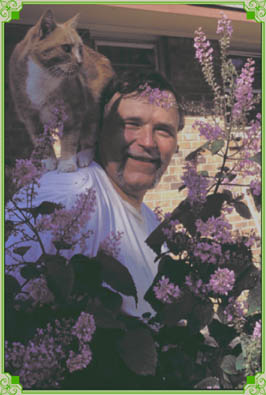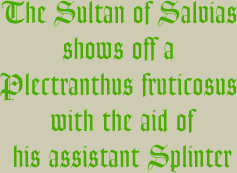 |
 |
| During the last twenty-five years, the genus Salvia has grown
in prominence in the horticultural world, finding especially receptive
fans in California and Great Britain. With the publication of Betsy Clebsch's
A
Book of Salvias: Sages for Every Garden and John Sutton's The
Gardener's Guide to Growing Salvias by Timber Press, the world now
has two valuable references for discovering and enjoying these plants.
Many botanic gardens are putting in display gardens, and many nurseries
are expanding their inventories to add even more sages. For some of the
best, check out the Links
to Botanic Gardens and Nurseries Page. Sages have arrived when
wholesale nurseries like Sunny Border
Nurseries, Inc. begin to aggressively add them to their inventories.
There are numerous nurseries and botanic gardens in Europe and Australia
that are doing the same.
These interests were advanced by numerous curious, determined, and engaged plantsmen from many backgrounds that met and exchanged ideas and plant materials in these forums. Their inner urges drove them to their discoveries, opportunities, and deeds, offering them all the challenges they could manage and more. Their experiences also led them to new, strong friendships with shared insights and awakened concerns in deeper levels of reality such as ecology, ethics, and even spiritual experiences and insights. Many of my botanical and horticultural contacts share much of my philosophy, curiosity, attitudes and world view. One of the reasons for writing this page is to provide details of my efforts.
For those of you who may be wondering about my role as the Sultan of Salvias and what I hope to accomplish, here is how I got started. The first turn began with my developing curiosity as an oldest child examining nature in my yard and the family farm. The second occurred when I realized that my career as a chemist would not necessarily be stable and that I would need to develop alternatives. Curious about chemistry, I asked my fourth grade teacher for help, and got her copy of a New York Regents chemistry textbook. After learning how to balance chemical equations, I got two Gilbert Chemistry sets, then ordered chemicals through the mail and accessed Partington and Partington's General and Inorganic Chemistry for College Students. I taught myself to learn how to learn chemistry' In high school, I switched to organic chemistry and built a two year lead on most other students. All these activities helped me occupy my very active mind, develop practical skills, and build confidence. Undergraduate years were dedicated to broadening my background to make myself a viable employee and ethical citizen. Growth during these years was painful but valuable. During my graduate school days at Carnegie-Mellon University in the late 60s and early 70s, I saw the opportunities diminish for natural products chemists. The job market split into specialties. Previously, most Ph.D. candidates in organic chemistry prepared for a position at a pharmaceutical firm, then tried for a less challenging job in some other specialty if they did not make the cut. Now opportunities to do graduate programs in specialties like polymer chemistry and other fields appeared. Less prestigious schools provided a spectrum of less expensive candidates for employers, were more affordable for their students, and could commit new technical resources for these specialties not available in the pharmaceutically oriented schools. Until the economy recovered from those years of recession, many Ph.D. candidates found themselves overqualified for the jobs that were available. With my deep need to do creative work, my psyche was poised for opportunities to do research in fields that did not require huge capital investments in scientific supplies and equipment. My farming background led me to horticulture and botany in the same way the natural laboratory of the family farm drew my curiosity towards chemistry while I was in grammar school. In the years that followed, I did not abandon my chemistry career. Postdoctoral positions added to my experience while searching for permanent employment, filling the remainder of my time with my alternate botanic interests. My business career finally got started as a flavor chemist at Lorillard Tobacco in Greensboro, lasting over fifteen years. Botany and horticulture were relegated to hobbies during periods of employment, realizing that they might be needed again should the economy prove to be fickle. This proved to be true seven years ago, and my career has cycled again, this time with a most pleasant ten month stint as a drug discovery chemist at Targacept, doing research for cures for Alzheimer's and Parkinson's diseases based on alpha-4,beta-2 nicotinic receptors
I remember buying my first Salvia from Heinz Groetzke of Meadowbrook Herb Garden in 1974. It was pineapple sage. I then stopped by at Logee's Greenhouses, on the way back home and bought several others, including Salvia dorisiana. Excitement about both the intensely scented foliage and flower colors prompted the discovery of other nurseries like Well Sweep and the botanic gardens and greenhouses at Smith College and Mt. Holyoke College. Learning that my collection could be increased by swapping germ plasm, the first Index Seminum was created, and contacts established with numerous botanic gardens and seedsmen like J. L. Hudson, Seedsman and Craig Dremann of Redwood City Seed Co. High points in the journey included a month on the road via Greyhound Ameripass that included visits to most of the California botanic gardens, Carroll Abbott's Green Horizons in Kerrville, Texas and Madalene Hill's Hilltop Herb Farm in Cleveland, Texas. The journey finished with a stop at Park Seed Company. It was satisfying to finally put faces to the voices on the other end of the phone and experience the gardens and plants they nourished. Other memorable experiences were the two trips to Mexico, the first with Manuel Flores of San Antonio, and Carl Schoenfeld and John G. Fairey of Yucca Do Nursery at Peckerwood Gardens of Hempstead, Texas. Overseas, I attended the first Advances in Labiatae Science Conference, held at the Royal Botanic Garden at Kew, followed by the international rock gardener's meeting of Alpines `91. Each of these experiences were richly rewarding because of all the contacts, plants, and experiences. The friendships built along the way have been one of the strongest incentives for continuing this enterprise. Instant bonding is the norm here, especially with outstanding champions of horticulture like Gwen and Panayoti Kelaidis of the Denver Botanic Gardens, and Michelle and Tony Avent of Plant Delights Nursery.
Going deeper and examining the expanding roots of my interests requires a quick look at the etymology of the two common words used to describe these plants. The word "sage" has its origins in Old French ("sauge" and "saige"), the first for the plant and the second for the one who is wise, perceptive, and discerning. Sauge goes back to Salvia in Latin and has a root meaning of safety and soundness. Saige has its roots in Latin sapiens, wise, originally from sapere, to know, taste The word "salvia" has its roots in Latin and comes from the same roots as salvation, and has a root meaning of safety. All Salvias presumably evolved from one species from Central Asia. They have managed to develop into over 900 different species, each the expression of the trip over time and space from their Eden. In that, they are a lot like Mankind. We all have a common ancestor, but are all of us very different in many aspects. In other words, Salvias can be seen as archetypes for the plant community that forms the Earth's biosphere. This concept might be useful filtering its way through Man's relevant disciplines and concerns by creating a new way to look at Nature.
Thus the driving force behind my attraction to Salvias is evolving into the Wisdom of Salvation and the Salvation of Wisdom. This fits in and is intimately linked to my interests in all kinds of other fields, stimulated by friendships that developed during my graduate school days at Carnegie-Mellon University from the mid 60s to the early 70s. Besides my fellow chemists, I met Renaissance scholars like Drs. Rolf and Elsa Von Eckartsburg. Stimulated by many discussions, I discovered and still pursue social sciences, theology, and humanities, such as many schools of psychology (especially Jungian, gestalt, and the works of Dr. Stanislav Grof), sociology, and especially ethics and comparative religion. Having been a successful flavor and fragrance and drug discovery chemist for most of my professional career, I've had to constantly keep my mind active and highly focused. Having developed many contacts with botanical gardens and professional botanists, I have strong interests in the environment and conservation. Combining my interests in chemistry, botany, and the humanities leads me to conflicts that test my assumptions and the intellectual instruments I use. For example, research with integrity both requires and develops sharp critical thinking, but that skill alone does not necessarily avoid the pitfall of naive realism: "What you see is what you get", followed by a rhetorical "What else do you need to know?" to force closure. This can be a useful and simple approach , but is limited and often overused and is a rarely elegant intellectual tool. Reductive thinking needs to be balanced with intuition. The trick is to keep the dialog between these aspects healthy and not destructive. Pursuing humanities with the same vigor and integrity helps the hard scientist from becoming a naive realist by showing him the limits of his thinking. The path to reality requires balancing cynicism and naiveté, operating from a stable and growing ground between these poles. Everyone who goes beyond the limits of his mind risks becoming a naive realist. However, it is necessary to test the boundaries to grow. To look at it from a political and religious point of view, he who errs consistently on the side of conservatism is a cynic, and he who errs consistently on the side of liberalism is a naïf. Striving to err consistently is asking to be drawn into intellectual, ethical, and spiritual sado-masochism that results in the end of growth. This is the built-in weakness of all ideologies. It is my hope to share the results of these experiences as much as possible with the viewers of this page. People are as essential to the community of Salvias as the plants themselves. The enthusiasm for Salvias can grow into efforts to keep the planet Earth green and into keep Mankind centered and aware. Remember, a giant may keep his head in the clouds only if his feet are securely placed on a stable, healthy, and nurturing Earth.
If I were born in Mediaeval times, I probably would have been a wandering monk, collecting new plants and experiences, traveling from monastery to monastery, and sharing herbal and healing arts and philosophical discussions with Meister Eckhart and Francis of Assisi.. Perhaps I'll get lucky and develop my home into a botanically oriented center serving as a modest modern equivalent for peace and enlightenment. As a means towards developing this goal, I've built up a library of around 200 reference works which I browse whenever I have the time, or when an urgent issue arises. Here is a page listing some useful references.. Some of my favorite seminal books
Here are a couple of national organizations that are contributing to this challenge in their own ways: |
| And one close to my home in the central North Carolina area: |
![]()
Links to Living Herbarium Pages:
![]()
Links to Other World of Salvia Pages: